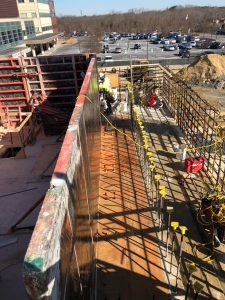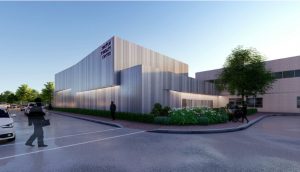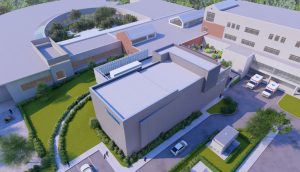Bringing State-of-the-Art Treatment to the People
Since opening the Roberts Proton Therapy Center in 2010, Penn Medicine has committed to bringing this cutting-edge cancer treatment technology to patients in other areas of Pennsylvania and southern New Jersey. In the last year, they have made amazing strides toward that goal by working with LF Driscoll (LFD) to build new proton therapy centers at Lancaster General Health and in partnership with Virtua Health at Virtua Voorhees Hospital.

Unlike conventional forms of radiation, proton therapy uses protons to target treatment down to the size, shape, and depth of the tumor, sparing healthy tissue from radiation. But because the protons create radiation through interaction with structural materials in the beam path, this form of treatment needs a facility that keeps the radiation within the treatment space. The solution? A concrete vault with walls and ceilings up to 7ft thick and a very detailed, very organized building infrastructure system to support it.
PRECISION AT WORK
On the surface, a concrete box sounds like a pretty simple design. But, says LFD project executive Michael Dolan, there’s a lot more to it than meets the eye. “Mass concrete pours require detailed planning, critical monitoring, and frequent testing to ensure the specifications are met,” he says. “With almost 60% of the MEP piping encapsulated in the concrete, BIM and virtual modeling of all the piping prior to the pour is critical. It was a much more intensive process than with any hospital I’ve ever worked on.”
Set in stone (or concrete). Because so much relies on the integrity of the concrete, LF Driscoll and its team had to ensure the concrete pours went off without a hitch. To do so, the team prepared the pour plans with precise 3D models and monitored the temperature of the concrete at every stage—as it pours, once it’s in place, and several days after—to ensure the temperature differential from the inner core to the outer surface does not exceed the allowable variance. “We did our pours at Virtua in the winter, so the tendency of having the concrete overheat was limited and only minimal efforts were needed, like insulated blankets or leaving the forms in place an extra day,” says Chris Donnelly, LFD project manager. “The continual monitoring with temperature probes installed in the pour helped us make sure there was no cracking or other issues.”
Virtual precision. The proton therapy equipment vendor, Varian, had a detailed set of drawings to indicate the mechanical requirements, conduit runs, and other specifics for each project. The LFD team employed virtual design and construction (VDC) to develop a 3D model early on to accurately coordinate between Varian, the design team, and the subcontractors. “The plans are very specific about where conduit can sit and come out of the walls,” says Craig Weckerly, senior MEP coordinator at LF Driscoll. “Not only does it need to tie in specifically to the equipment, but it needs to prevent radiation from being able to travel the path of the conduit.”

Ready for liftoff. The entire construction plan revolves around a “ready for equipment,” or RFE, deadline—the day that Varian will deliver the 220-ton cyclotron equipment. LF Driscoll worked backwards from that date to ensure all elements of the concrete vault were 100% ready for delivery day. “We left two 20ft by 30ft entries in the concrete roof with temporary structural lids that Varian lifts to drop in the equipment,” says Dolan. “Then we install 3ft-thick precast concrete to enclose the roof, add shielding blocks between the gantry and the equipment, and turn the space back over to Varian for their testing and commissioning process.” LF Driscoll then completes the remaining site work and turns the building over to the owner.
EXPERIENCE MATTERS
The fixed deadline of the RFE added some pressure, but having a consistent, trusted project team certainly helped. LF Driscoll had early discussions with subcontractors to explain the unique nature of their scope and ensure procurement and schedules were coordinated to the requirements before and
after the RFE period.

In addition, LFD worked with Tsoi Kobus and Penn Medicine to build one of the largest proton therapy centers in the world in 2009: Penn Medicine’s Roberts Proton Therapy Center. This same team reunited, along with the addition of Varian, to build both the Lancaster Health and Virtua Voorhees
projects, giving them a shared understanding of the process, challenges, and schedule.
“Working with the same team made it very easy to talk together about both projects,” says Weckerly. “We were able to take all the lessons learned on the Lancaster project and apply them to Virtua. We all felt very comfortable together.”
As of this spring, Varian continues to prepare the proton therapy center at the Penn Medicine Lancaster General Ann B. Barshinger Cancer Institute for finishing touches by LF Driscoll before its expected opening next year. At Virtua Voorhees, the concrete vault and the installation of structural steel and
overhead equipment are ready for the equipment delivery. And while that progress is gratifying, it’s the lasting effects of the project the team is most looking forward to.
“None of us treats patients, but we build projects that help better people’s lives,” says Dolan. “These are state-of-the-art medical facilities that make this treatment available to so many more people. It’s a privilege to be part of that.”
